Psychometric Analysis: Self-Esteem, Depression, and Anxiety Quiz
VerifiedAdded on 2023/01/17
|18
|3259
|37
Report
AI Summary
This report details a psychometric analysis of an online self-esteem quiz, investigating its validity and reliability using data from 120 participants. The analysis employed methods such as Cronbach's alpha, inter-item correlation, and factor analysis to assess the psychometric properties of the quiz. The study found that certain items (1, 3, and 7) negatively impacted the Cronbach's alpha and were subsequently deleted. The analysis revealed a negative correlation between self-esteem and both depression and anxiety, as well as a positive correlation between self-esteem and the Rosenberg Self-Esteem Scale. These findings suggest that higher self-esteem is associated with lower levels of depression and anxiety. The report concludes that the self-esteem measurement is reliable after item deletion, indicating that the scale is internally consistent. Furthermore, the factor analysis indicated the scales are unidimensional. This report contributes to the understanding of the psychometric properties of self-esteem measurement tools and their relationship with mental health indicators.

1
Title: Psychometric Analysis
Task: Conduct a psychometric analysis of the measurements of self-esteem,
Depression, and Anxiety
Institution:
School:
Lecturer:
Student:
Module Name:
Module number:
Title: Psychometric Analysis
Task: Conduct a psychometric analysis of the measurements of self-esteem,
Depression, and Anxiety
Institution:
School:
Lecturer:
Student:
Module Name:
Module number:
Paraphrase This Document
Need a fresh take? Get an instant paraphrase of this document with our AI Paraphraser
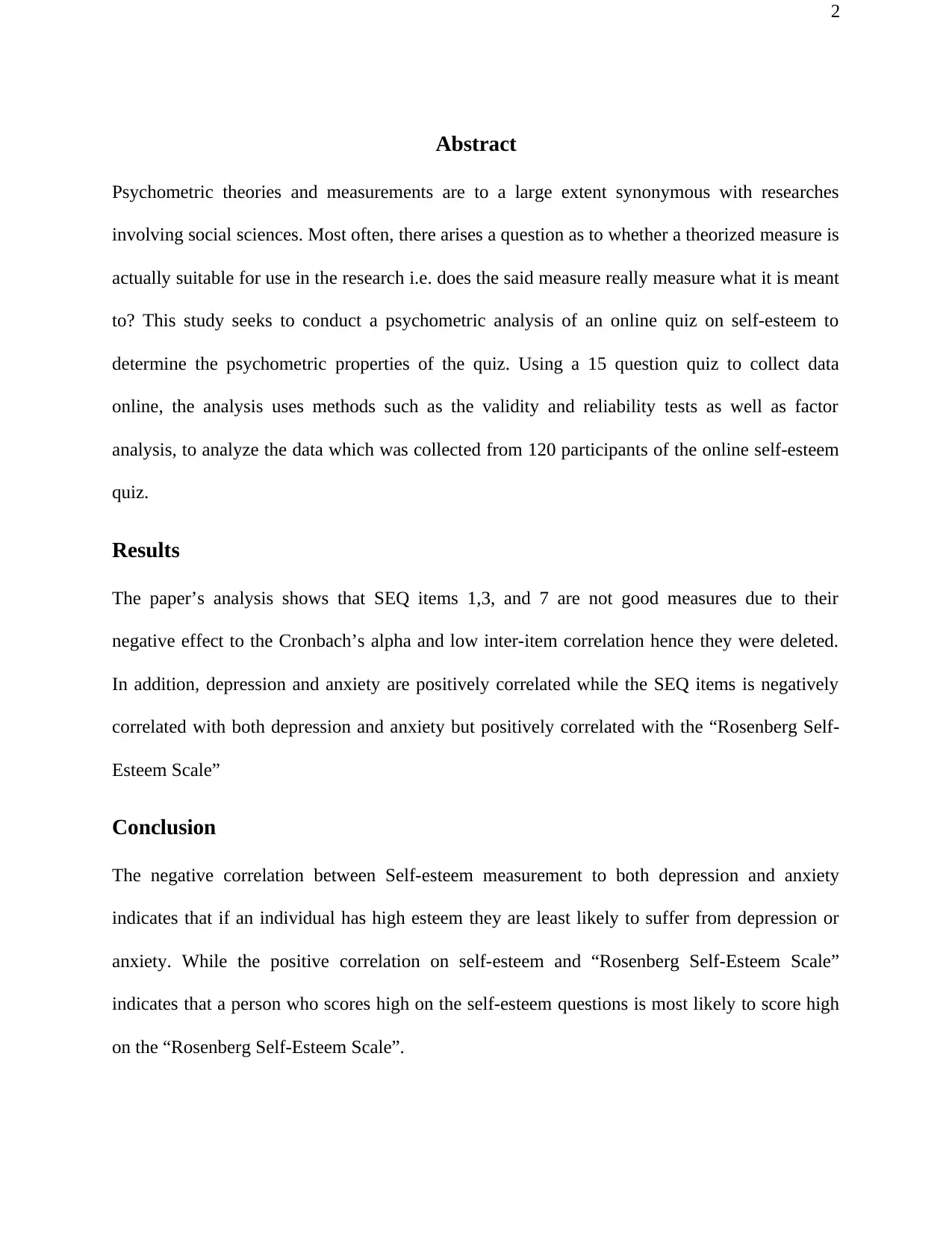
2
Abstract
Psychometric theories and measurements are to a large extent synonymous with researches
involving social sciences. Most often, there arises a question as to whether a theorized measure is
actually suitable for use in the research i.e. does the said measure really measure what it is meant
to? This study seeks to conduct a psychometric analysis of an online quiz on self-esteem to
determine the psychometric properties of the quiz. Using a 15 question quiz to collect data
online, the analysis uses methods such as the validity and reliability tests as well as factor
analysis, to analyze the data which was collected from 120 participants of the online self-esteem
quiz.
Results
The paper’s analysis shows that SEQ items 1,3, and 7 are not good measures due to their
negative effect to the Cronbach’s alpha and low inter-item correlation hence they were deleted.
In addition, depression and anxiety are positively correlated while the SEQ items is negatively
correlated with both depression and anxiety but positively correlated with the “Rosenberg Self-
Esteem Scale”
Conclusion
The negative correlation between Self-esteem measurement to both depression and anxiety
indicates that if an individual has high esteem they are least likely to suffer from depression or
anxiety. While the positive correlation on self-esteem and “Rosenberg Self-Esteem Scale”
indicates that a person who scores high on the self-esteem questions is most likely to score high
on the “Rosenberg Self-Esteem Scale”.
Abstract
Psychometric theories and measurements are to a large extent synonymous with researches
involving social sciences. Most often, there arises a question as to whether a theorized measure is
actually suitable for use in the research i.e. does the said measure really measure what it is meant
to? This study seeks to conduct a psychometric analysis of an online quiz on self-esteem to
determine the psychometric properties of the quiz. Using a 15 question quiz to collect data
online, the analysis uses methods such as the validity and reliability tests as well as factor
analysis, to analyze the data which was collected from 120 participants of the online self-esteem
quiz.
Results
The paper’s analysis shows that SEQ items 1,3, and 7 are not good measures due to their
negative effect to the Cronbach’s alpha and low inter-item correlation hence they were deleted.
In addition, depression and anxiety are positively correlated while the SEQ items is negatively
correlated with both depression and anxiety but positively correlated with the “Rosenberg Self-
Esteem Scale”
Conclusion
The negative correlation between Self-esteem measurement to both depression and anxiety
indicates that if an individual has high esteem they are least likely to suffer from depression or
anxiety. While the positive correlation on self-esteem and “Rosenberg Self-Esteem Scale”
indicates that a person who scores high on the self-esteem questions is most likely to score high
on the “Rosenberg Self-Esteem Scale”.
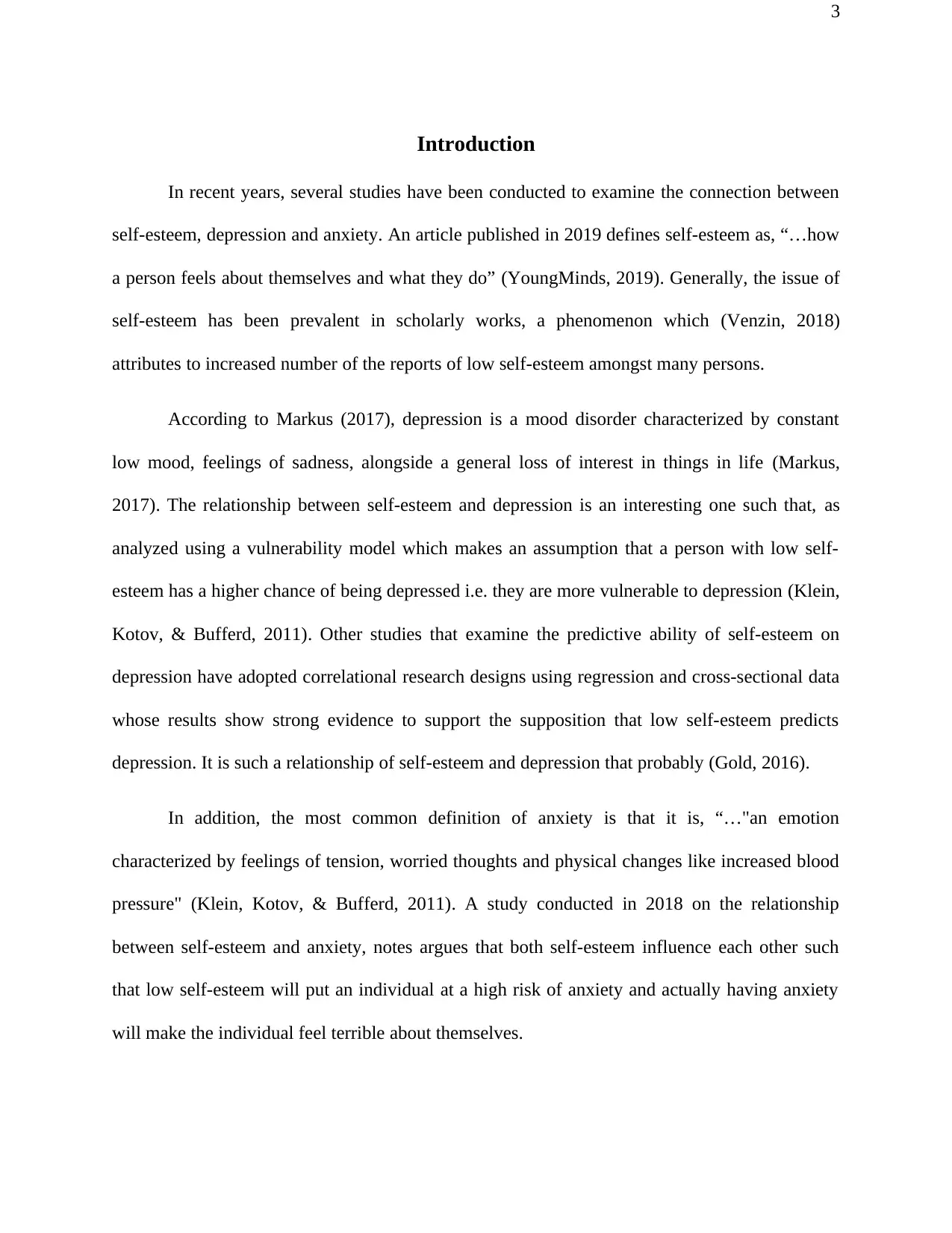
3
Introduction
In recent years, several studies have been conducted to examine the connection between
self-esteem, depression and anxiety. An article published in 2019 defines self-esteem as, “…how
a person feels about themselves and what they do” (YoungMinds, 2019). Generally, the issue of
self-esteem has been prevalent in scholarly works, a phenomenon which (Venzin, 2018)
attributes to increased number of the reports of low self-esteem amongst many persons.
According to Markus (2017), depression is a mood disorder characterized by constant
low mood, feelings of sadness, alongside a general loss of interest in things in life (Markus,
2017). The relationship between self-esteem and depression is an interesting one such that, as
analyzed using a vulnerability model which makes an assumption that a person with low self-
esteem has a higher chance of being depressed i.e. they are more vulnerable to depression (Klein,
Kotov, & Bufferd, 2011). Other studies that examine the predictive ability of self-esteem on
depression have adopted correlational research designs using regression and cross-sectional data
whose results show strong evidence to support the supposition that low self-esteem predicts
depression. It is such a relationship of self-esteem and depression that probably (Gold, 2016).
In addition, the most common definition of anxiety is that it is, “…"an emotion
characterized by feelings of tension, worried thoughts and physical changes like increased blood
pressure" (Klein, Kotov, & Bufferd, 2011). A study conducted in 2018 on the relationship
between self-esteem and anxiety, notes argues that both self-esteem influence each other such
that low self-esteem will put an individual at a high risk of anxiety and actually having anxiety
will make the individual feel terrible about themselves.
Introduction
In recent years, several studies have been conducted to examine the connection between
self-esteem, depression and anxiety. An article published in 2019 defines self-esteem as, “…how
a person feels about themselves and what they do” (YoungMinds, 2019). Generally, the issue of
self-esteem has been prevalent in scholarly works, a phenomenon which (Venzin, 2018)
attributes to increased number of the reports of low self-esteem amongst many persons.
According to Markus (2017), depression is a mood disorder characterized by constant
low mood, feelings of sadness, alongside a general loss of interest in things in life (Markus,
2017). The relationship between self-esteem and depression is an interesting one such that, as
analyzed using a vulnerability model which makes an assumption that a person with low self-
esteem has a higher chance of being depressed i.e. they are more vulnerable to depression (Klein,
Kotov, & Bufferd, 2011). Other studies that examine the predictive ability of self-esteem on
depression have adopted correlational research designs using regression and cross-sectional data
whose results show strong evidence to support the supposition that low self-esteem predicts
depression. It is such a relationship of self-esteem and depression that probably (Gold, 2016).
In addition, the most common definition of anxiety is that it is, “…"an emotion
characterized by feelings of tension, worried thoughts and physical changes like increased blood
pressure" (Klein, Kotov, & Bufferd, 2011). A study conducted in 2018 on the relationship
between self-esteem and anxiety, notes argues that both self-esteem influence each other such
that low self-esteem will put an individual at a high risk of anxiety and actually having anxiety
will make the individual feel terrible about themselves.
⊘ This is a preview!⊘
Do you want full access?
Subscribe today to unlock all pages.

Trusted by 1+ million students worldwide
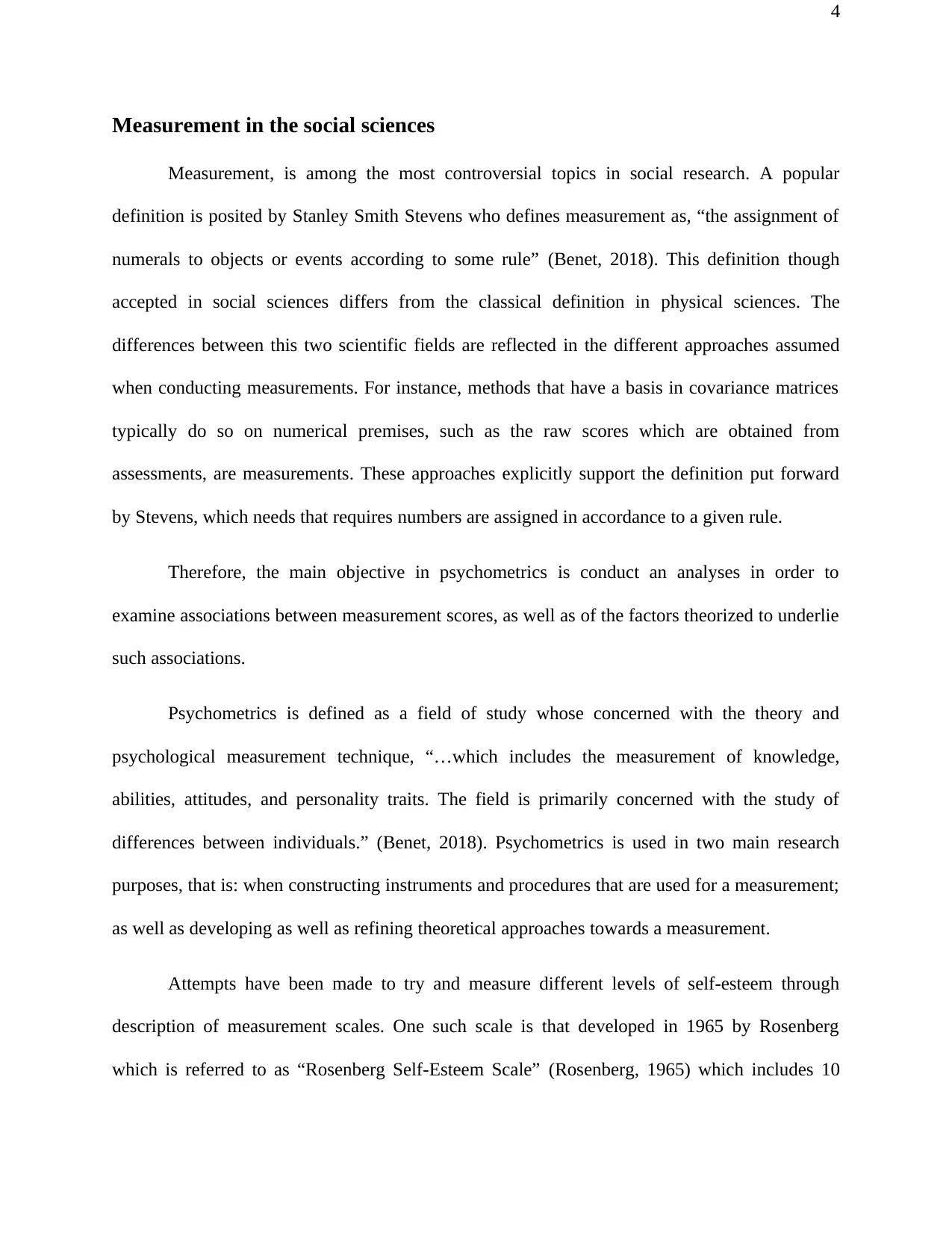
4
Measurement in the social sciences
Measurement, is among the most controversial topics in social research. A popular
definition is posited by Stanley Smith Stevens who defines measurement as, “the assignment of
numerals to objects or events according to some rule” (Benet, 2018). This definition though
accepted in social sciences differs from the classical definition in physical sciences. The
differences between this two scientific fields are reflected in the different approaches assumed
when conducting measurements. For instance, methods that have a basis in covariance matrices
typically do so on numerical premises, such as the raw scores which are obtained from
assessments, are measurements. These approaches explicitly support the definition put forward
by Stevens, which needs that requires numbers are assigned in accordance to a given rule.
Therefore, the main objective in psychometrics is conduct an analyses in order to
examine associations between measurement scores, as well as of the factors theorized to underlie
such associations.
Psychometrics is defined as a field of study whose concerned with the theory and
psychological measurement technique, “…which includes the measurement of knowledge,
abilities, attitudes, and personality traits. The field is primarily concerned with the study of
differences between individuals.” (Benet, 2018). Psychometrics is used in two main research
purposes, that is: when constructing instruments and procedures that are used for a measurement;
as well as developing as well as refining theoretical approaches towards a measurement.
Attempts have been made to try and measure different levels of self-esteem through
description of measurement scales. One such scale is that developed in 1965 by Rosenberg
which is referred to as “Rosenberg Self-Esteem Scale” (Rosenberg, 1965) which includes 10
Measurement in the social sciences
Measurement, is among the most controversial topics in social research. A popular
definition is posited by Stanley Smith Stevens who defines measurement as, “the assignment of
numerals to objects or events according to some rule” (Benet, 2018). This definition though
accepted in social sciences differs from the classical definition in physical sciences. The
differences between this two scientific fields are reflected in the different approaches assumed
when conducting measurements. For instance, methods that have a basis in covariance matrices
typically do so on numerical premises, such as the raw scores which are obtained from
assessments, are measurements. These approaches explicitly support the definition put forward
by Stevens, which needs that requires numbers are assigned in accordance to a given rule.
Therefore, the main objective in psychometrics is conduct an analyses in order to
examine associations between measurement scores, as well as of the factors theorized to underlie
such associations.
Psychometrics is defined as a field of study whose concerned with the theory and
psychological measurement technique, “…which includes the measurement of knowledge,
abilities, attitudes, and personality traits. The field is primarily concerned with the study of
differences between individuals.” (Benet, 2018). Psychometrics is used in two main research
purposes, that is: when constructing instruments and procedures that are used for a measurement;
as well as developing as well as refining theoretical approaches towards a measurement.
Attempts have been made to try and measure different levels of self-esteem through
description of measurement scales. One such scale is that developed in 1965 by Rosenberg
which is referred to as “Rosenberg Self-Esteem Scale” (Rosenberg, 1965) which includes 10
Paraphrase This Document
Need a fresh take? Get an instant paraphrase of this document with our AI Paraphraser
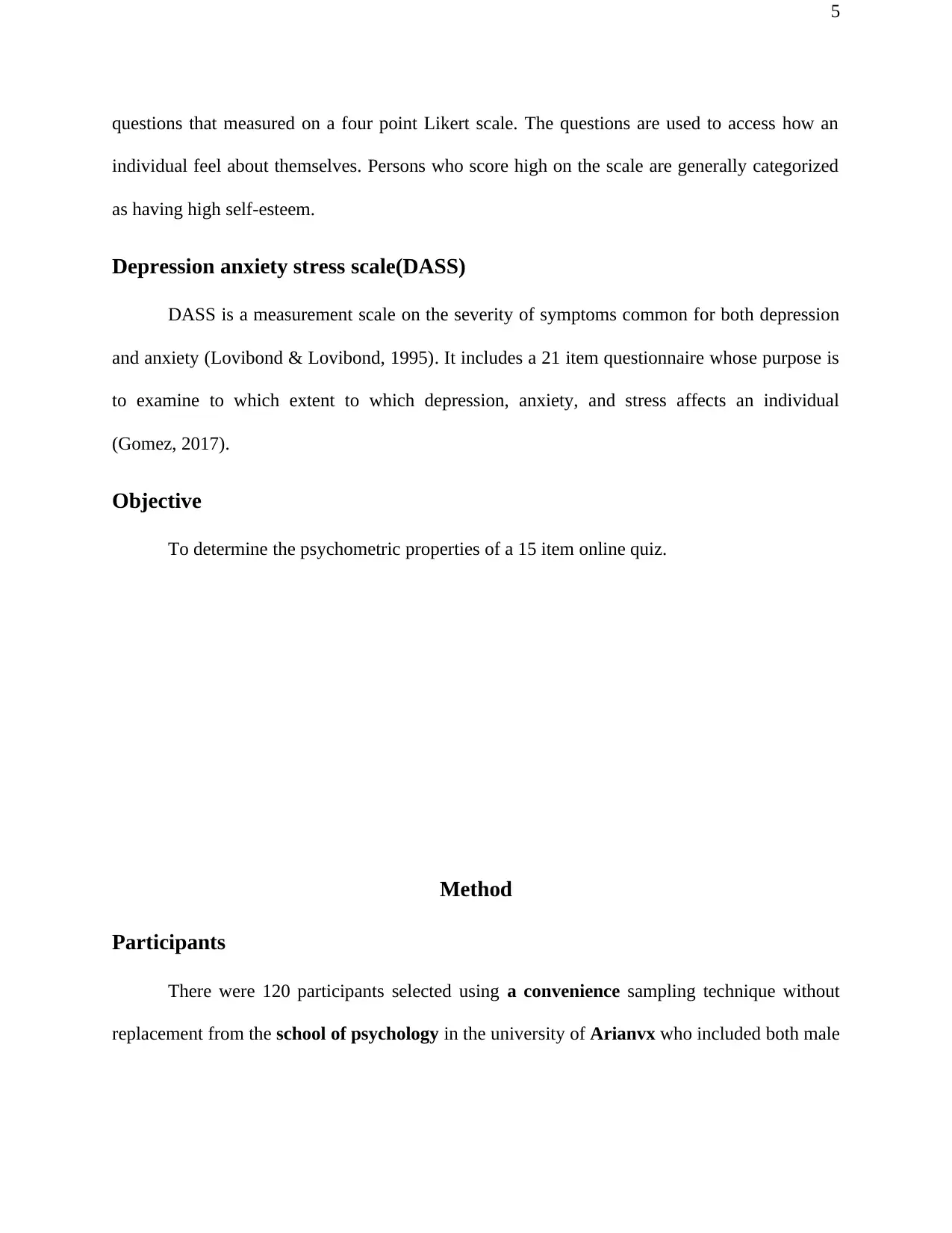
5
questions that measured on a four point Likert scale. The questions are used to access how an
individual feel about themselves. Persons who score high on the scale are generally categorized
as having high self-esteem.
Depression anxiety stress scale(DASS)
DASS is a measurement scale on the severity of symptoms common for both depression
and anxiety (Lovibond & Lovibond, 1995). It includes a 21 item questionnaire whose purpose is
to examine to which extent to which depression, anxiety, and stress affects an individual
(Gomez, 2017).
Objective
To determine the psychometric properties of a 15 item online quiz.
Method
Participants
There were 120 participants selected using a convenience sampling technique without
replacement from the school of psychology in the university of Arianvx who included both male
questions that measured on a four point Likert scale. The questions are used to access how an
individual feel about themselves. Persons who score high on the scale are generally categorized
as having high self-esteem.
Depression anxiety stress scale(DASS)
DASS is a measurement scale on the severity of symptoms common for both depression
and anxiety (Lovibond & Lovibond, 1995). It includes a 21 item questionnaire whose purpose is
to examine to which extent to which depression, anxiety, and stress affects an individual
(Gomez, 2017).
Objective
To determine the psychometric properties of a 15 item online quiz.
Method
Participants
There were 120 participants selected using a convenience sampling technique without
replacement from the school of psychology in the university of Arianvx who included both male
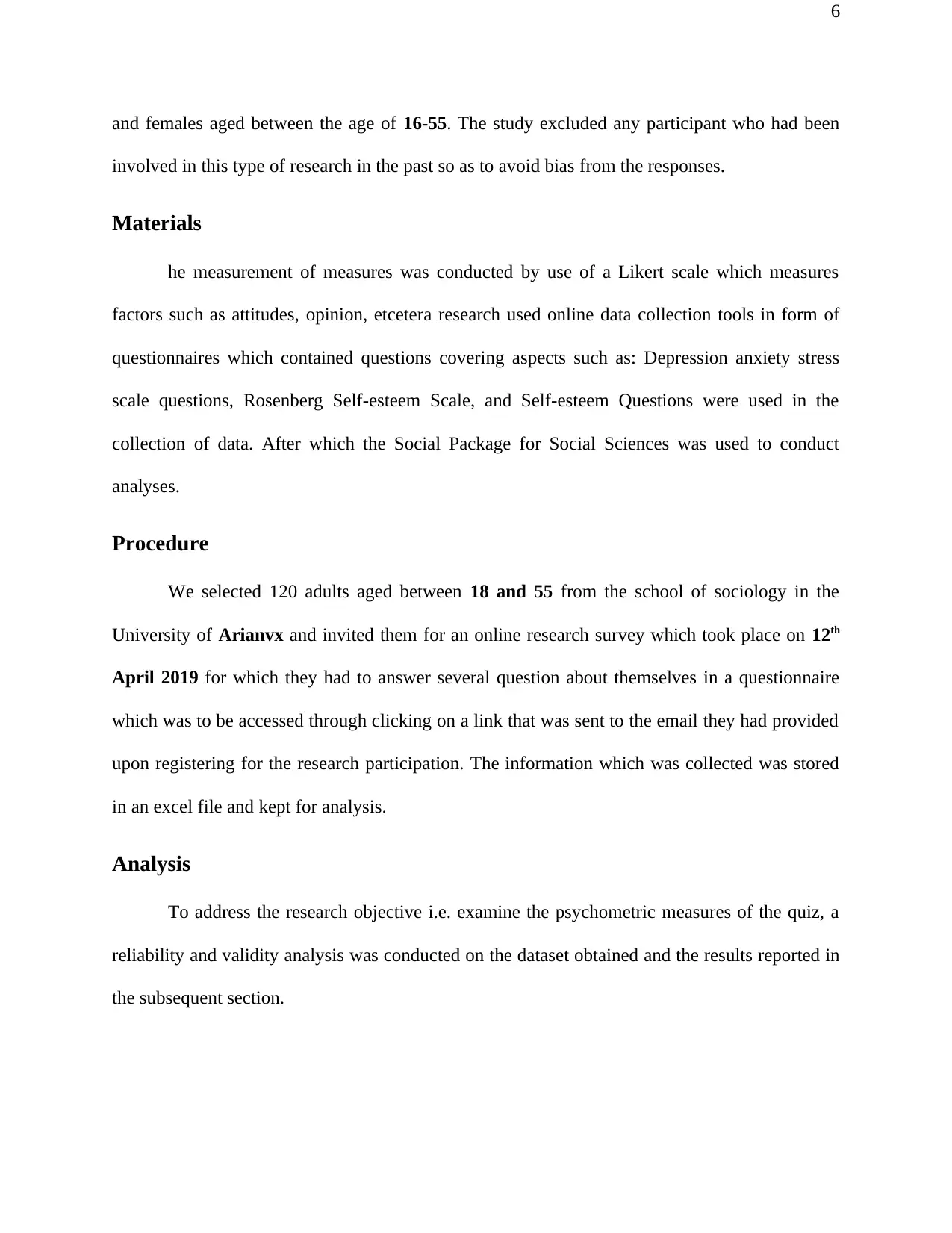
6
and females aged between the age of 16-55. The study excluded any participant who had been
involved in this type of research in the past so as to avoid bias from the responses.
Materials
he measurement of measures was conducted by use of a Likert scale which measures
factors such as attitudes, opinion, etcetera research used online data collection tools in form of
questionnaires which contained questions covering aspects such as: Depression anxiety stress
scale questions, Rosenberg Self-esteem Scale, and Self-esteem Questions were used in the
collection of data. After which the Social Package for Social Sciences was used to conduct
analyses.
Procedure
We selected 120 adults aged between 18 and 55 from the school of sociology in the
University of Arianvx and invited them for an online research survey which took place on 12th
April 2019 for which they had to answer several question about themselves in a questionnaire
which was to be accessed through clicking on a link that was sent to the email they had provided
upon registering for the research participation. The information which was collected was stored
in an excel file and kept for analysis.
Analysis
To address the research objective i.e. examine the psychometric measures of the quiz, a
reliability and validity analysis was conducted on the dataset obtained and the results reported in
the subsequent section.
and females aged between the age of 16-55. The study excluded any participant who had been
involved in this type of research in the past so as to avoid bias from the responses.
Materials
he measurement of measures was conducted by use of a Likert scale which measures
factors such as attitudes, opinion, etcetera research used online data collection tools in form of
questionnaires which contained questions covering aspects such as: Depression anxiety stress
scale questions, Rosenberg Self-esteem Scale, and Self-esteem Questions were used in the
collection of data. After which the Social Package for Social Sciences was used to conduct
analyses.
Procedure
We selected 120 adults aged between 18 and 55 from the school of sociology in the
University of Arianvx and invited them for an online research survey which took place on 12th
April 2019 for which they had to answer several question about themselves in a questionnaire
which was to be accessed through clicking on a link that was sent to the email they had provided
upon registering for the research participation. The information which was collected was stored
in an excel file and kept for analysis.
Analysis
To address the research objective i.e. examine the psychometric measures of the quiz, a
reliability and validity analysis was conducted on the dataset obtained and the results reported in
the subsequent section.
⊘ This is a preview!⊘
Do you want full access?
Subscribe today to unlock all pages.

Trusted by 1+ million students worldwide
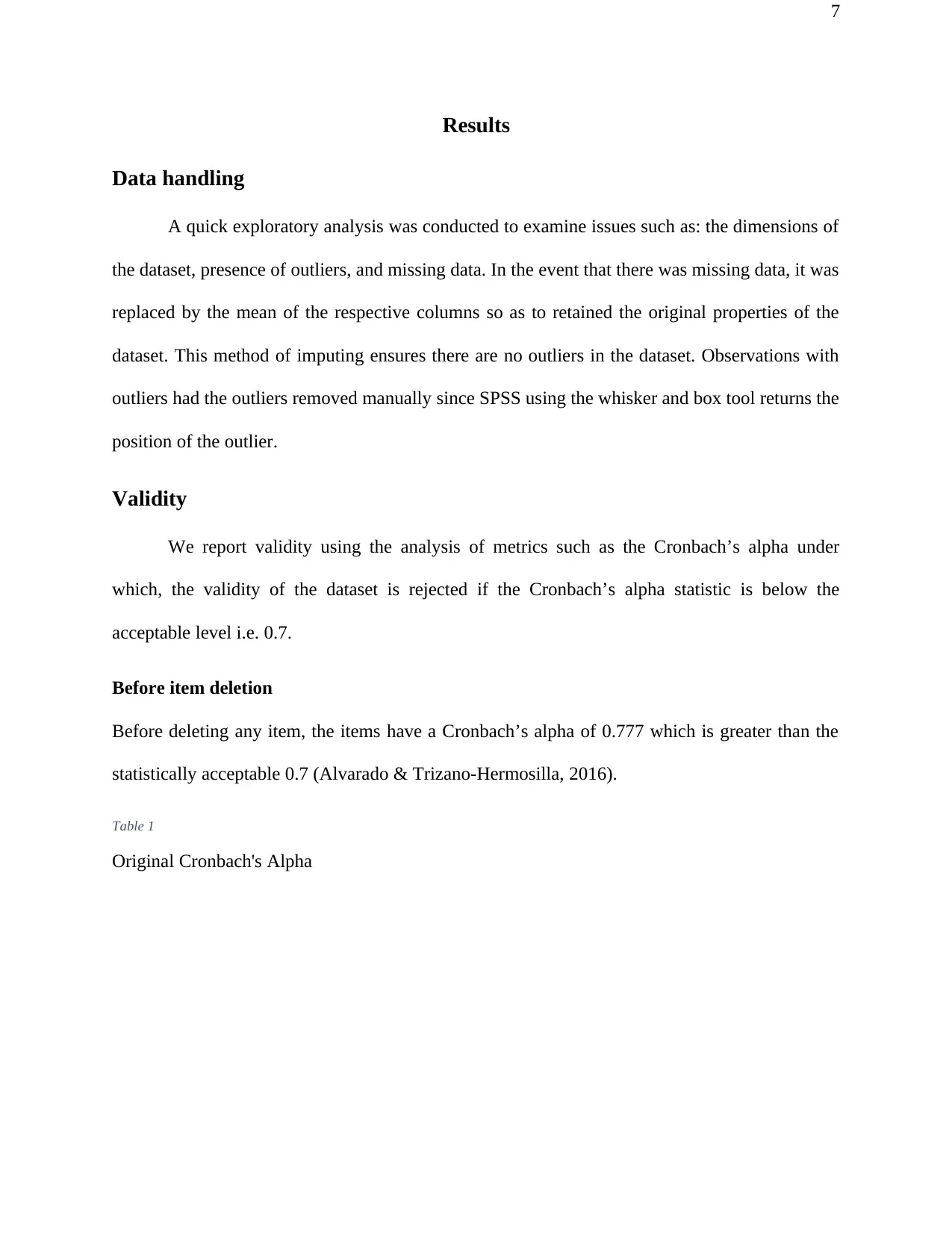
7
Results
Data handling
A quick exploratory analysis was conducted to examine issues such as: the dimensions of
the dataset, presence of outliers, and missing data. In the event that there was missing data, it was
replaced by the mean of the respective columns so as to retained the original properties of the
dataset. This method of imputing ensures there are no outliers in the dataset. Observations with
outliers had the outliers removed manually since SPSS using the whisker and box tool returns the
position of the outlier.
Validity
We report validity using the analysis of metrics such as the Cronbach’s alpha under
which, the validity of the dataset is rejected if the Cronbach’s alpha statistic is below the
acceptable level i.e. 0.7.
Before item deletion
Before deleting any item, the items have a Cronbach’s alpha of 0.777 which is greater than the
statistically acceptable 0.7 (Alvarado & Trizano-Hermosilla, 2016).
Table 1
Original Cronbach's Alpha
Results
Data handling
A quick exploratory analysis was conducted to examine issues such as: the dimensions of
the dataset, presence of outliers, and missing data. In the event that there was missing data, it was
replaced by the mean of the respective columns so as to retained the original properties of the
dataset. This method of imputing ensures there are no outliers in the dataset. Observations with
outliers had the outliers removed manually since SPSS using the whisker and box tool returns the
position of the outlier.
Validity
We report validity using the analysis of metrics such as the Cronbach’s alpha under
which, the validity of the dataset is rejected if the Cronbach’s alpha statistic is below the
acceptable level i.e. 0.7.
Before item deletion
Before deleting any item, the items have a Cronbach’s alpha of 0.777 which is greater than the
statistically acceptable 0.7 (Alvarado & Trizano-Hermosilla, 2016).
Table 1
Original Cronbach's Alpha
Paraphrase This Document
Need a fresh take? Get an instant paraphrase of this document with our AI Paraphraser
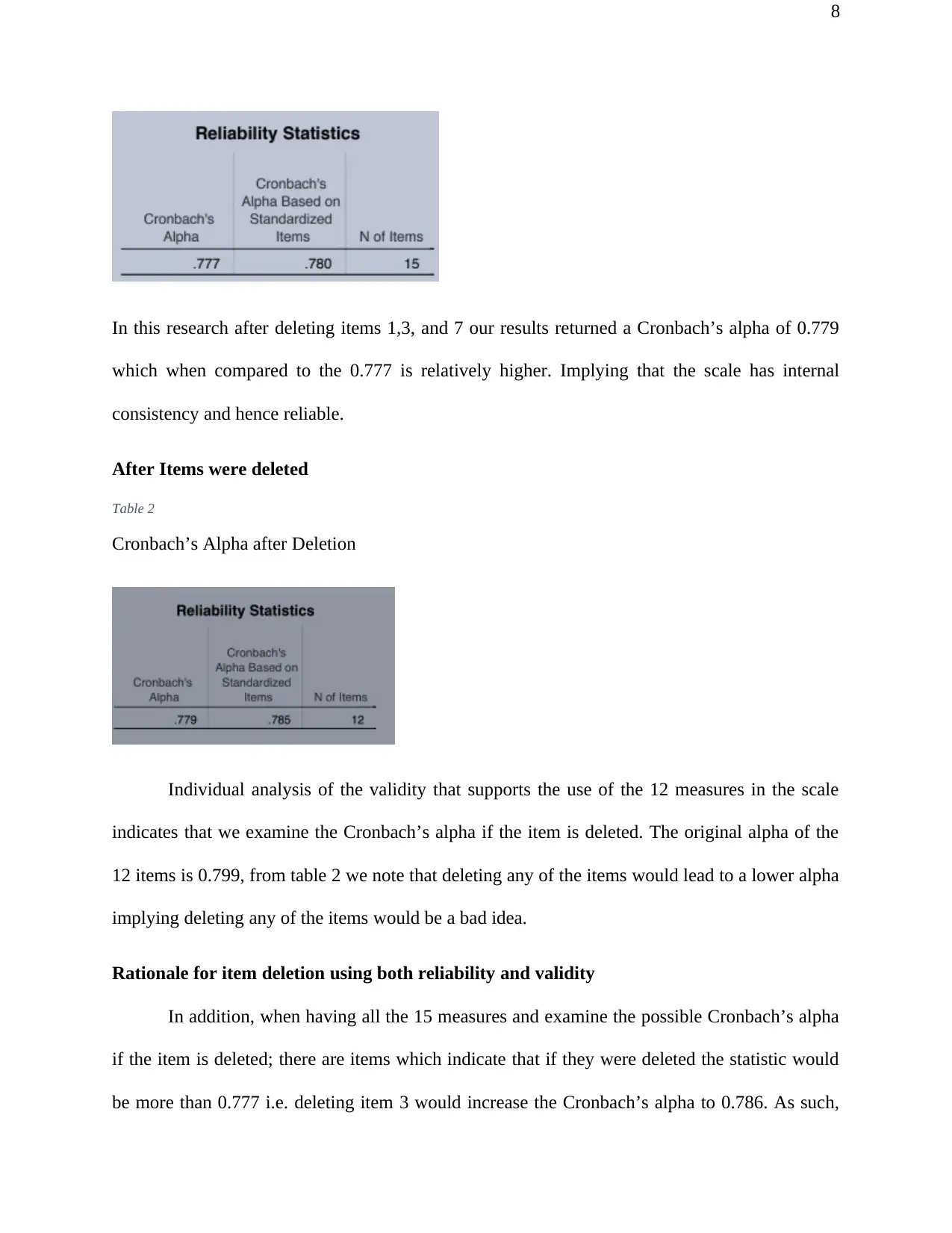
8
In this research after deleting items 1,3, and 7 our results returned a Cronbach’s alpha of 0.779
which when compared to the 0.777 is relatively higher. Implying that the scale has internal
consistency and hence reliable.
After Items were deleted
Table 2
Cronbach’s Alpha after Deletion
Individual analysis of the validity that supports the use of the 12 measures in the scale
indicates that we examine the Cronbach’s alpha if the item is deleted. The original alpha of the
12 items is 0.799, from table 2 we note that deleting any of the items would lead to a lower alpha
implying deleting any of the items would be a bad idea.
Rationale for item deletion using both reliability and validity
In addition, when having all the 15 measures and examine the possible Cronbach’s alpha
if the item is deleted; there are items which indicate that if they were deleted the statistic would
be more than 0.777 i.e. deleting item 3 would increase the Cronbach’s alpha to 0.786. As such,
In this research after deleting items 1,3, and 7 our results returned a Cronbach’s alpha of 0.779
which when compared to the 0.777 is relatively higher. Implying that the scale has internal
consistency and hence reliable.
After Items were deleted
Table 2
Cronbach’s Alpha after Deletion
Individual analysis of the validity that supports the use of the 12 measures in the scale
indicates that we examine the Cronbach’s alpha if the item is deleted. The original alpha of the
12 items is 0.799, from table 2 we note that deleting any of the items would lead to a lower alpha
implying deleting any of the items would be a bad idea.
Rationale for item deletion using both reliability and validity
In addition, when having all the 15 measures and examine the possible Cronbach’s alpha
if the item is deleted; there are items which indicate that if they were deleted the statistic would
be more than 0.777 i.e. deleting item 3 would increase the Cronbach’s alpha to 0.786. As such,
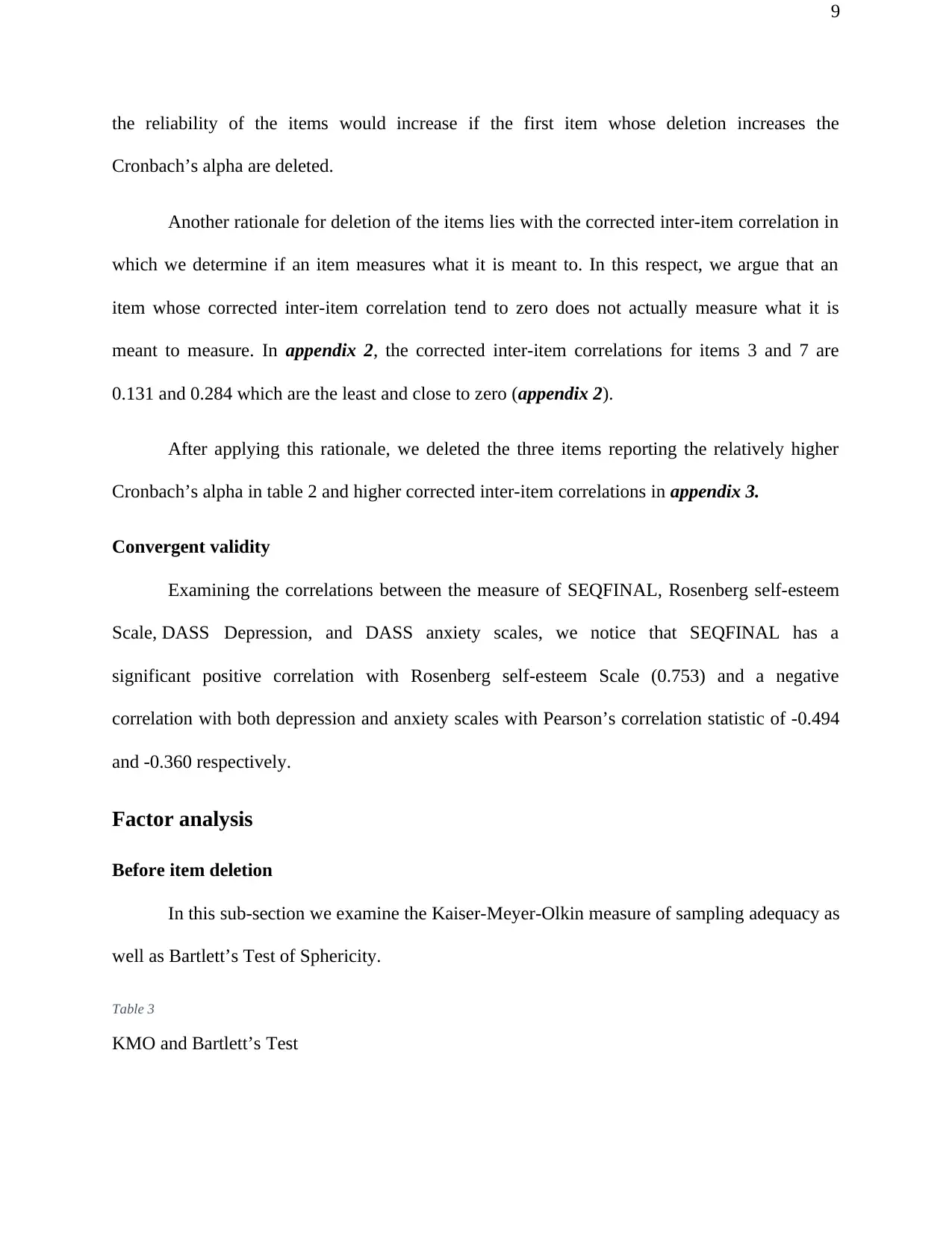
9
the reliability of the items would increase if the first item whose deletion increases the
Cronbach’s alpha are deleted.
Another rationale for deletion of the items lies with the corrected inter-item correlation in
which we determine if an item measures what it is meant to. In this respect, we argue that an
item whose corrected inter-item correlation tend to zero does not actually measure what it is
meant to measure. In appendix 2, the corrected inter-item correlations for items 3 and 7 are
0.131 and 0.284 which are the least and close to zero (appendix 2).
After applying this rationale, we deleted the three items reporting the relatively higher
Cronbach’s alpha in table 2 and higher corrected inter-item correlations in appendix 3.
Convergent validity
Examining the correlations between the measure of SEQFINAL, Rosenberg self-esteem
Scale, DASS Depression, and DASS anxiety scales, we notice that SEQFINAL has a
significant positive correlation with Rosenberg self-esteem Scale (0.753) and a negative
correlation with both depression and anxiety scales with Pearson’s correlation statistic of -0.494
and -0.360 respectively.
Factor analysis
Before item deletion
In this sub-section we examine the Kaiser-Meyer-Olkin measure of sampling adequacy as
well as Bartlett’s Test of Sphericity.
Table 3
KMO and Bartlett’s Test
the reliability of the items would increase if the first item whose deletion increases the
Cronbach’s alpha are deleted.
Another rationale for deletion of the items lies with the corrected inter-item correlation in
which we determine if an item measures what it is meant to. In this respect, we argue that an
item whose corrected inter-item correlation tend to zero does not actually measure what it is
meant to measure. In appendix 2, the corrected inter-item correlations for items 3 and 7 are
0.131 and 0.284 which are the least and close to zero (appendix 2).
After applying this rationale, we deleted the three items reporting the relatively higher
Cronbach’s alpha in table 2 and higher corrected inter-item correlations in appendix 3.
Convergent validity
Examining the correlations between the measure of SEQFINAL, Rosenberg self-esteem
Scale, DASS Depression, and DASS anxiety scales, we notice that SEQFINAL has a
significant positive correlation with Rosenberg self-esteem Scale (0.753) and a negative
correlation with both depression and anxiety scales with Pearson’s correlation statistic of -0.494
and -0.360 respectively.
Factor analysis
Before item deletion
In this sub-section we examine the Kaiser-Meyer-Olkin measure of sampling adequacy as
well as Bartlett’s Test of Sphericity.
Table 3
KMO and Bartlett’s Test
⊘ This is a preview!⊘
Do you want full access?
Subscribe today to unlock all pages.

Trusted by 1+ million students worldwide
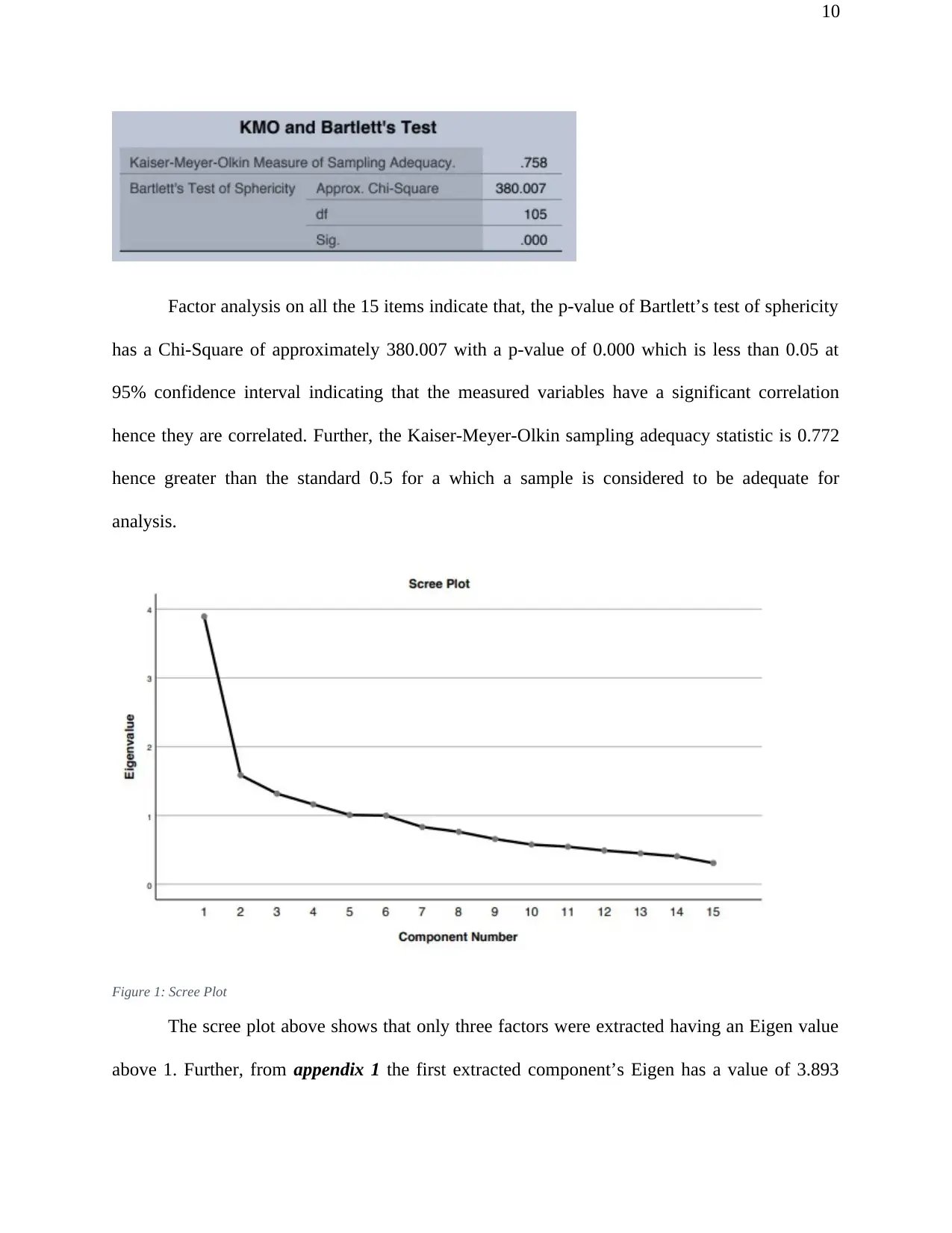
10
Factor analysis on all the 15 items indicate that, the p-value of Bartlett’s test of sphericity
has a Chi-Square of approximately 380.007 with a p-value of 0.000 which is less than 0.05 at
95% confidence interval indicating that the measured variables have a significant correlation
hence they are correlated. Further, the Kaiser-Meyer-Olkin sampling adequacy statistic is 0.772
hence greater than the standard 0.5 for a which a sample is considered to be adequate for
analysis.
Figure 1: Scree Plot
The scree plot above shows that only three factors were extracted having an Eigen value
above 1. Further, from appendix 1 the first extracted component’s Eigen has a value of 3.893
Factor analysis on all the 15 items indicate that, the p-value of Bartlett’s test of sphericity
has a Chi-Square of approximately 380.007 with a p-value of 0.000 which is less than 0.05 at
95% confidence interval indicating that the measured variables have a significant correlation
hence they are correlated. Further, the Kaiser-Meyer-Olkin sampling adequacy statistic is 0.772
hence greater than the standard 0.5 for a which a sample is considered to be adequate for
analysis.
Figure 1: Scree Plot
The scree plot above shows that only three factors were extracted having an Eigen value
above 1. Further, from appendix 1 the first extracted component’s Eigen has a value of 3.893
Paraphrase This Document
Need a fresh take? Get an instant paraphrase of this document with our AI Paraphraser
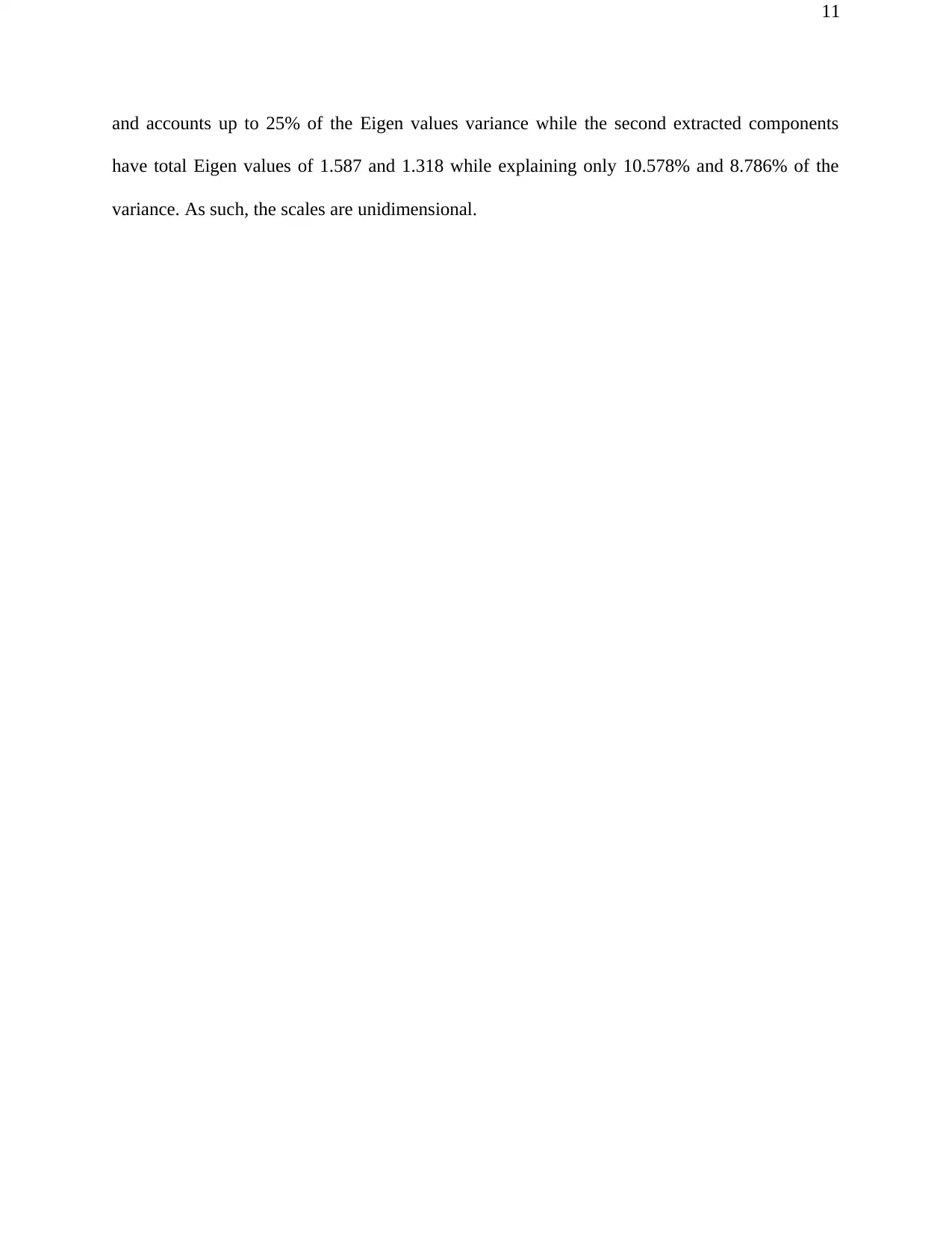
11
and accounts up to 25% of the Eigen values variance while the second extracted components
have total Eigen values of 1.587 and 1.318 while explaining only 10.578% and 8.786% of the
variance. As such, the scales are unidimensional.
and accounts up to 25% of the Eigen values variance while the second extracted components
have total Eigen values of 1.587 and 1.318 while explaining only 10.578% and 8.786% of the
variance. As such, the scales are unidimensional.

12
Discussion
Ideally, validity is the extent to which a measure is deemed valid to be adopted as a
research instrument that is, does the measure really measure what it is defined to measure?
(SPSS test, 2017). So as to conduct an analysis on the validity of a new measure, it is specifically
important that a researcher carries out validity alongside reliability analyses of the measures used
in the collection of data including any other measures that are newly defined as well as
examining the effect of not having some measures.
In this study, we seek to examine the psychometric properties of the research quiz which
include analysis of factors such as reliability and validity of the questions in the research. The
original measures for self-esteem included 15 questions which were meant to measure ted egress
of self-esteem among the research participants i.e. the self-esteem indices which when reliability
analysis was conducted they proof to be a reliable scale with a Cronchbach statistic being 0.77
(Alvarado & Trizano-Hermosilla, 2016) which however was lower than when the items “How I
feel depends on what other think of me”, “I easily seek help and accept help from others” , and “I
am uncomfortable expressing my opinion and feelings in my personal relationships”. The
question as to whether actually measure the degree of self-esteem was thus raised and the items
were subsequently deleted.
Further correlation analysis under factor analysis indicates a significantly positive
correlation between the measures of self-esteem and the Rosenberg Self-Esteem Scale. As such
we can argue that the Rosenberg Self-Esteem Scale is a good scale for measuring self-esteem.
However, Self-esteem is negatively correlate with both Depression anxiety stress scale(DASS)
for depression as well as anxiety which was also true for Rosenberg Self-esteem Scale and
Discussion
Ideally, validity is the extent to which a measure is deemed valid to be adopted as a
research instrument that is, does the measure really measure what it is defined to measure?
(SPSS test, 2017). So as to conduct an analysis on the validity of a new measure, it is specifically
important that a researcher carries out validity alongside reliability analyses of the measures used
in the collection of data including any other measures that are newly defined as well as
examining the effect of not having some measures.
In this study, we seek to examine the psychometric properties of the research quiz which
include analysis of factors such as reliability and validity of the questions in the research. The
original measures for self-esteem included 15 questions which were meant to measure ted egress
of self-esteem among the research participants i.e. the self-esteem indices which when reliability
analysis was conducted they proof to be a reliable scale with a Cronchbach statistic being 0.77
(Alvarado & Trizano-Hermosilla, 2016) which however was lower than when the items “How I
feel depends on what other think of me”, “I easily seek help and accept help from others” , and “I
am uncomfortable expressing my opinion and feelings in my personal relationships”. The
question as to whether actually measure the degree of self-esteem was thus raised and the items
were subsequently deleted.
Further correlation analysis under factor analysis indicates a significantly positive
correlation between the measures of self-esteem and the Rosenberg Self-Esteem Scale. As such
we can argue that the Rosenberg Self-Esteem Scale is a good scale for measuring self-esteem.
However, Self-esteem is negatively correlate with both Depression anxiety stress scale(DASS)
for depression as well as anxiety which was also true for Rosenberg Self-esteem Scale and
⊘ This is a preview!⊘
Do you want full access?
Subscribe today to unlock all pages.

Trusted by 1+ million students worldwide
1 out of 18
Your All-in-One AI-Powered Toolkit for Academic Success.
+13062052269
info@desklib.com
Available 24*7 on WhatsApp / Email
![[object Object]](/_next/static/media/star-bottom.7253800d.svg)
Unlock your academic potential
Copyright © 2020–2025 A2Z Services. All Rights Reserved. Developed and managed by ZUCOL.

